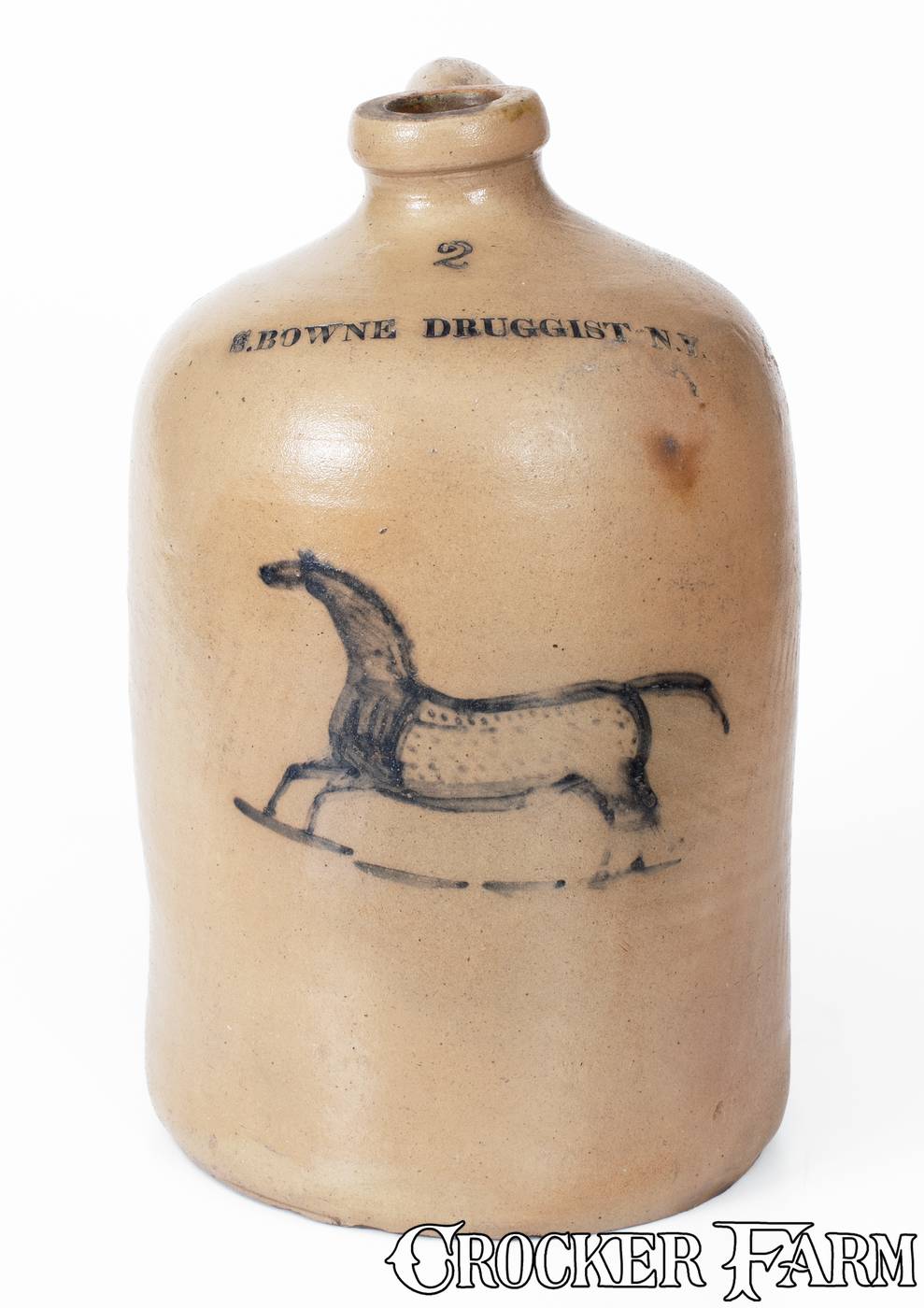A New York City Stoneware Druggist's Jug
A couple of years ago, the New York State Museum posted a brief write-up highlighting some Commeraw fragments excavated at 146 Pearl Street in lower Manhattan. You can see them here. This is a site that would once have been part of the East River, but was customarily developed into a usable lot in the early eighteenth century. (Manhattan's shoreline has changed radically since the first European settlers set foot on it.) During Commeraw's time as a pottery owner, 146 Pearl was operated as an apothecary, first by Oliver Hull & Son (this son being John, a partnership ending about 1798); then by John Hull, who in the fall of 1800 took his son-in-law, Richard M. Bowne, into the business--the firm of Hull & Bowne, Druggists trading out of that location until 1826. (This despite Richard M. Bowne's untimely death in 1818.)
Louis Berger & Son excavated 146 Pearl as part of a broader project in 1982 and their report details the use of the site as both a druggists' shop and residence. For example, 1808 and 1813 property tax listings note that while Hull & Bowne operated the store, Richard M. Bowne's family appears to have occupied living quarters there. In 1820, Oliver Hull (son of John and brother-in-law of Richard M. Bowne) had a similar arrangement.

A utilitarian "CORLEARS HOOK" jug by Thomas W. Commeraw, similar to what was excavated at the Bowne property.
The New York State Museum's brief story on the Commeraw fragments describes them as waste from the Bownes' household and the time period lines up correctly with Commeraw's production timeline. But the recovery of these sherds points to something else: That as druggists, Hull & Bowne must have been ordering stoneware from Commeraw, perhaps both for internal use / storage, as well as for external sale to customers. Druggists routinely acquired stoneware containers in which to sell various medicines, chemicals, paints, dyes, oils and other products. As I take up in Commeraw's Stoneware, identifying specific merchants with whom Commeraw was trading is very tricky, this difficulty highlighted by the fact that it sometimes takes literal digging in the dirt to do so. These fragments were an important discovery.

Stoneware jug bearing a galloping horse decoration and made for Samuel Bowne, New York City druggist.
Our Summer 2024 auction features a Bowne family stoneware jug, made a couple of decades after Commeraw left Manhattan. Bearing the stamp "S. BOWNE / DRUGGIST / N.Y.," this two-gallon jug bears the ultra-rare decoration of a galloping horse upon its front. Horse decorations like this are extremely rare in American stoneware, but even more so on utilitarian advertising jugs.
The "S. BOWNE" of the jug is Samuel Bowne, the son of the aforementioned Richard M. Bowne. Samuel, born about 1812, would have been roughly six years old when his father passed away, but he followed him into the druggists' trade, being taken into partnership by his uncle, Oliver Hull, in the summer of 1833, trading out of 128 Maiden Lane as "Hull & Bowne." We can give the jug a fairly tight window for its manufacture: On January 1, 1838 Samuel Bowne announced that he would be continuing the business on his own, so this would mark the earliest possible dating for the jug. In early 1839 he moved to 4 Liberty Street but went bankrupt in 1841. In 1843 he acquired another Bowne family owned druggist shop at 83 John Street, where he had lately been employed. By the publication of the 1849 city directory he was called a "late" druggist, and he probably moved out of that trade in 1848. Our guess is that the jug was made closer to the beginning of Bowne's run, circa 1840.
Beginning with Thomas Commeraw's "Ashmore's Genuine Cordials" jug (the first known American stoneware advertising jug) along with his now-iconic oyster jars, it is difficult to overstate my fondness for New York advertising stoneware. Samuel Bowne's wonderful jug provides us yet another glimpse through the window of time into the close relationship between American stoneware potters and merchants of all kinds, highlighting the absolutely vital role that potters played in keeping the American way of life up and running.

Earliest known American stoneware advertising jug, made by Thomas W. Commeraw: Ashmore's Genuine Cordials, Prepared by W. Field Only
Sources:
New York City Directories.
An Archaeological and Historical Assessment of the Barclays Bank Site, 100 Water Street, New York, New York, The Cultural Resource Group, Louis Berger & Associates, Inc., November 1983.
New York Mercantile Advertiser, October 8, 1800.
New-York Daily Advertiser, July 30, 1818.
The New-York Evening Post, January 2, 1827.
The [New York] Evening Post, July 10, 1833.
The [New York] Evening Post, October 10, 1838.
The New York Journal of Commerce, February 22, 1839.
The [New York] Evening Post, March 5, 1841.
New-York Commercial Advertiser, January 5, 1843.
Oliver Hull, Book of the Hulls (New York: Peter Eckler, 1863), pp. 32-36.
The Druggists Circular and Chemical Gazette XXXIV:10 (October 1890), pg. 238.
